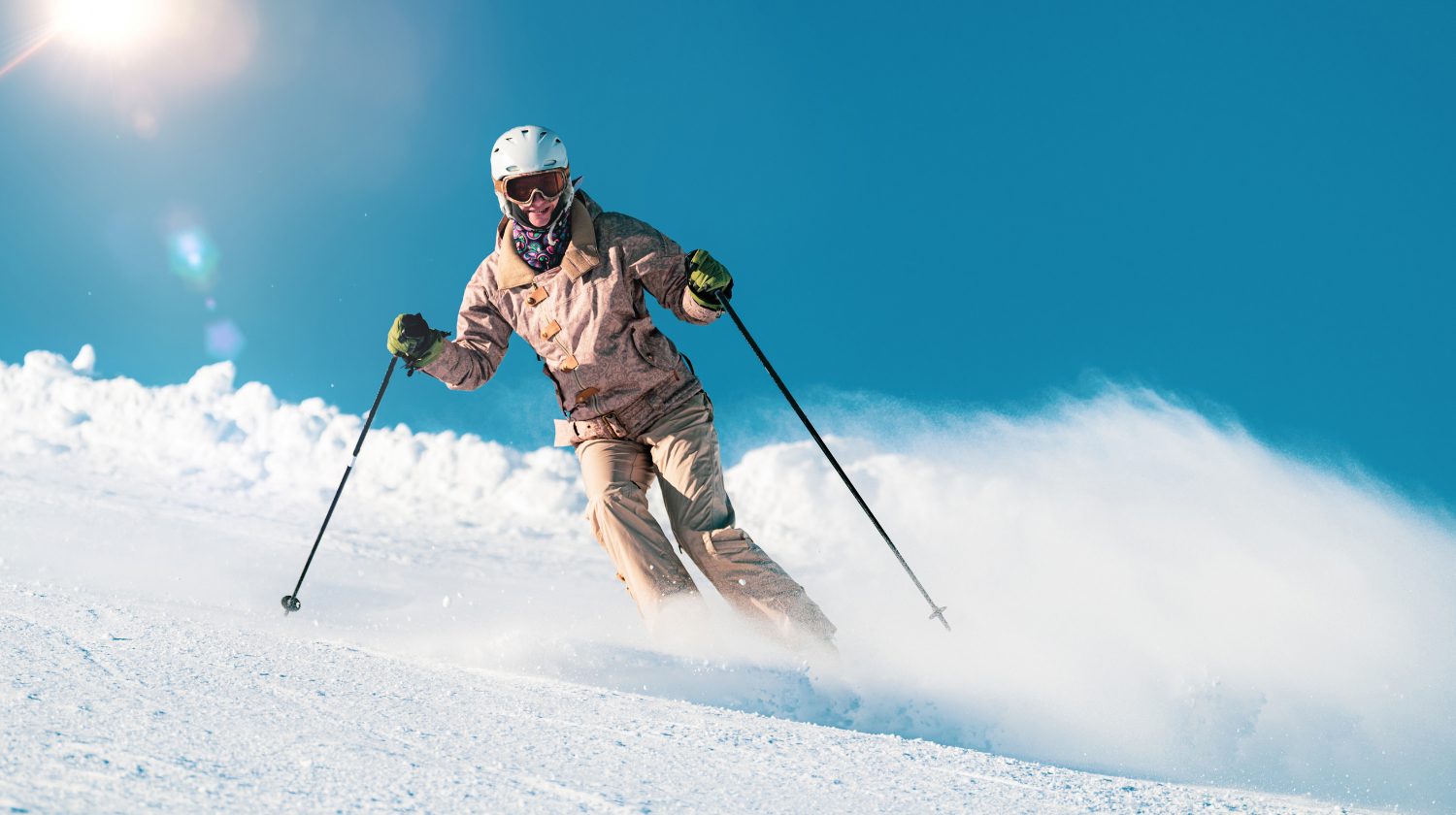Can You Ski While Pregnant? Benefits, Drawbacks & Safety Tips 2024

Keeping active is recommended for women during pregnancy. Physical activity is beneficial to the expectant mother’s health in most cases. The Royal College of Obstetricians and Gynecologists[1] recommends at least 150 minutes of moderate-intensity physical activity every week.
If you do winter sports like skiing or snowboarding, you might be itching to get back on the slopes. Or you planned a trip to a mountain lodge this winter before you found out about your pregnancy. With the precautions one takes during a pregnancy, you might want to know: Can you ski while pregnant?
Is It Safe To Ski While Pregnant?
The answer here is maybe — but probably no. If you are used to being physically active, including skiing, you might be able to continue during your pregnancy with precautions, but it is prudent for you to choose another time. Pregnant women are advised to avoid some high-risk activities that may pose a physical risk to the baby.
Skiing[2] is the use of two flat runners to glide over snow. Usually, skiing is practiced as a form of transportation, recreation, or a sport. It is exhilarating, as you usually glide down with refreshing air hitting your face. Skiing requires a lot of lower body strength and balance that comes from your core.
The second trimester might be the safest time for skiing since there is less risk of miscarriage and your belly throwing out your balance on the slopes. On the other hand, you may need to avoid skiing during early pregnancy since there’s naturally a higher risk of miscarriage in your first trimester. You may also have lower energy levels due to morning sickness during early pregnancy. In your third trimester, the extra weight of your belly may affect your balance on the slopes.
Women are recommended to perform two hours and 30 minutes of moderate-intensity exercise per week. You may continue if you were already doing vigorous-intensity activities,[3] in which you cannot talk without catching your breath. Get cleared by your medical provider before starting or continuing to exercise.
Benefits Of Skiing During Pregnancy
There might be benefits to skiing, with precautions, like maintaining cardiovascular function, burning calories, strengthening the lower body, and decreasing the risk of gestational diabetes.
Both the Royal College of Obstetricians and Gynecologists and the 2018 Physical Activity Guidelines for Americans[4] recommend that women practice physical activity during and after pregnancy. Both guidelines agree on the following benefits:
Helps Manage Weight
Exercise helps the body burn calories. This can make it easier for you to manage your weight, prevent excessive weight gain during pregnancy and return to your pre-pregnancy weight.
Excessive weight gain during pregnancy is associated with increased fetal weight and risk for future obesity for your baby, as well as more difficult births and an increased need for C-sections.
Improves Mood
Working out[5] can help decrease the symptoms of postpartum depression. Although there is not much evidence that it helps with prenatal depression symptoms or anxiety. You may still benefit from using yoga or any other exercise to improve your mood.
Physical activity outdoors, in association with exposure to nature[6] may also be an additional factor that helps with your mental health, decrease stress, and improves sleep. So skiing or spending time outdoors may also improve your mood.
Aids In Sleep
People who work out[7] sleep better and longer. Moderate-intensity exercise is associated with improved sleep quality. You should avoid working out late in the evening, however, which may affect your sleep by delaying melatonin secretion.
Prevents Hyperglycemia
Exercise helps you use up glucose. It may also help with insulin resistance, which in the end can decrease the risk of the development of gestational diabetes mellitus.
GDM[8] not only increases your and your baby’s risk of developing type 2 diabetes postpartum, but it can also lead to a baby with a higher weight than average and an increased risk of requiring a cesarean section.
Prevents High Blood Pressure And Preeclampsia
Physical activity can also decrease the risk of preeclampsia and gestational high blood pressure. Preeclampsia is characterized by elevated blood pressure, high levels of protein in the urine, and edema in the arms and legs. Both conditions during pregnancy can have harmful effects on the fetus and the mother.
It is important to note that it is not only skiing which can provide these benefits, exercising overall does.
Risks Of Skiing While Pregnant
Like many activities and sports, skiing might pose risks:
Altitude
Pregnant women,[9] in particular, may need to be careful when exploring higher altitudes. The American College of Obstetricians and Gynecologists advises that pregnant women that live near sea level may practice physical activity below 6,000 feet. In contrast, those that live at higher altitudes might exercise above that.
At altitudes 8,000 feet above sea level, oxygen levels decrease in the environment and also in your blood. You may experience altitude sickness if you don’t take breaks to allow your body to adapt. It is preferable to find lower-altitude places to ski. Also, keep in mind it can take time to acclimate to the altitudes, often for several days.
Dehydration
While working out, it is important to hydrate adequately. Adequate fluid consumption[10] in pregnancy while working out is important for temperature regulation and preventing overheating. Water helps transport nutrients in your body and the placenta and, later in your pregnancy, contributes to amniotic fluid, crucial in the baby’s lung development.
Accidents
We all remember cartoons of skiing depicting hitting a tree or colliding with other people. Your body — abdominal wall, uterine wall, and the buoyancy of amniotic fluid — do a good job of reducing the impact of blows to the fetus. No fetus can be protected from impacts beyond those of everyday life. Impacts suffered while skiing can be as damaging as a car accident.
Safety Tips For Skiing While Pregnant
Self Monitor
Let your body be your guide. Stop if you feel any discomfort, pain, or cramps. Listen to your body when it tells you something is not right.
Prepare For Altitude
As mentioned before, allow your body to acclimate to the altitude. It might be a good idea to either take a rest at your lodging for a couple of days to acclimate to the increased altitude to prevent altitude sickness, even if you are an experienced skier.
Play It Safe
It may be a good idea to ski in an area with few to no people to avoid collisions and injury. You may be a skilled skier, but others may be learning, so it may be best to avoid crowds.
Try to stay on smaller slopes and avoid going too fast down inclines. This is to decrease the risk of you getting hurt if an accident occurs.
Stay Hydrated And Warm
Not only will you need to drink your regular 8 to 12 cups of liquids daily, take sips of water while working out to maintain hydration and adequate body temperature regulation.
In addition, do not forget to sport proper ski clothing or snow clothes. Make sure you feel comfortable so your body has a proper temperature.
Activities You Should Avoid When Pregnant
According to American Pregnancy Association,[11] skiing is an activity that should be avoided during pregnancy. The APA and the 2018 Physical Activity Guidelines for Americans also recommend avoiding:
- Diving.
- Contact sports.
- Horseback riding.
- Jet skiing.
- Soccer.
- Basketball.
- Exercises at higher altitudes.
On the other hand, some activities to consider are:
- Brisk walks.
- Swimming, water aerobics.
- Yoga, with modification.
- Dancing.
- Cycling, stationery.
- Resistance exercises with weights or resistance bands.
- Aerobics.
The main recommendation for what physical activities to avoid depends on the medical history of miscarriages, health problems, physical fitness before your pregnancy, experience, and skill level in that activity.
Take into account that most guidelines for physical activity are based on the premise that these people are jumping into it from a sedentary lifestyle. If you are an experienced skier, discuss with your doctor whether you can continue your previous training or skiing activities.
The Bottom Line
The APA recommends that if you are pregnant, you shouldn’t ski. It all comes down to falls and injuries, assuming you’ve acclimated to the altitude. Falls and injuries are accidents that no one can ever predict. If you have questions about which particular activities you can perform, consult first with your OBGYN.
Otherwise, if you want to keep active during the winter, go snowshoeing, walk on a trail, or maybe just sit and play in the snow. You can also practice activities indoors like using a heated swimming pool. No matter what the decision is, feel free to move.
+ 11 sources
Health Canal avoids using tertiary references. We have strict sourcing guidelines and rely on peer-reviewed studies, academic researches from medical associations and institutions. To ensure the accuracy of articles in Health Canal, you can read more about the editorial process here
- RCOG. (2020). Physical activity and pregnancy | RCOG. [online] Available at: https://www.rcog.org.uk/for-the-public/browse-all-patient-information-leaflets/physical-activity-and-pregnancy/.
- Skiinghistory.org. (2018). A Short History of Skis | International Skiing History Association. [online] Available at: https://www.skiinghistory.org/history/short-history-skis-0.
- Anon, (2023). Measuring Physical Activity Intensity. [online] Available at: https://www.cdc.gov/physicalactivity/basics/measuring/index.html.
- Physical Activity Guidelines for Americans 2 nd edition. (n.d.). [online] Available at: https://health.gov/sites/default/files/2019-09/Physical_Activity_Guidelines_2nd_edition.pdf#page=79.
- DIPIETRO, L., EVENSON, K.R., BLOODGOOD, B., SPROW, K., TROIANO, R.P., PIERCY, K.L., VAUX-BJERKE, A. and POWELL, K.E. (2019). Benefits of Physical Activity during Pregnancy and Postpartum: An Umbrella Review. Medicine & Science in Sports & Exercise, [online] 51(6), pp.1292–1302. doi:10.1249/mss.0000000000001941.
- Science Advances. (2019). Nature and mental health: An ecosystem service perspective. [online] Available at: https://www.science.org/doi/10.1126/sciadv.aax0903?url_ver=Z39.88-2003&rfr_id=ori:rid:crossref.org&rfr_dat=cr_pub%20%200pubmed.
- Sejbuk, M., Mirończuk-Chodakowska, I. and Witkowska, A.M. (2022). Sleep Quality: A Narrative Review on Nutrition, Stimulants, and Physical Activity as Important Factors. Nutrients, [online] 14(9), p.1912. doi:10.3390/nu14091912.
- and, D. (2023). Definition & Facts of Gestational Diabetes. [online] National Institute of Diabetes and Digestive and Kidney Diseases. Available at: https://www.niddk.nih.gov/health-information/diabetes/overview/what-is-diabetes/gestational/definition-facts.
- McManis, B.G. (2021). Integrative Review of Exercise at Altitude during Pregnancy. International Journal of Environmental Research and Public Health, [online] 18(17), p.9272. doi:10.3390/ijerph18179272.
- APA Admin (2014). Dehydration During Pregnancy. [online] American Pregnancy Association. Available at: https://americanpregnancy.org/healthy-pregnancy/pregnancy-complications/dehydration-pregnancy/.
- editor (2018). Activities to Avoid During Pregnancy. [online] American Pregnancy Association. Available at: https://americanpregnancy.org/healthy-pregnancy/is-it-safe/activities-to-avoid-during-pregnancy/.



